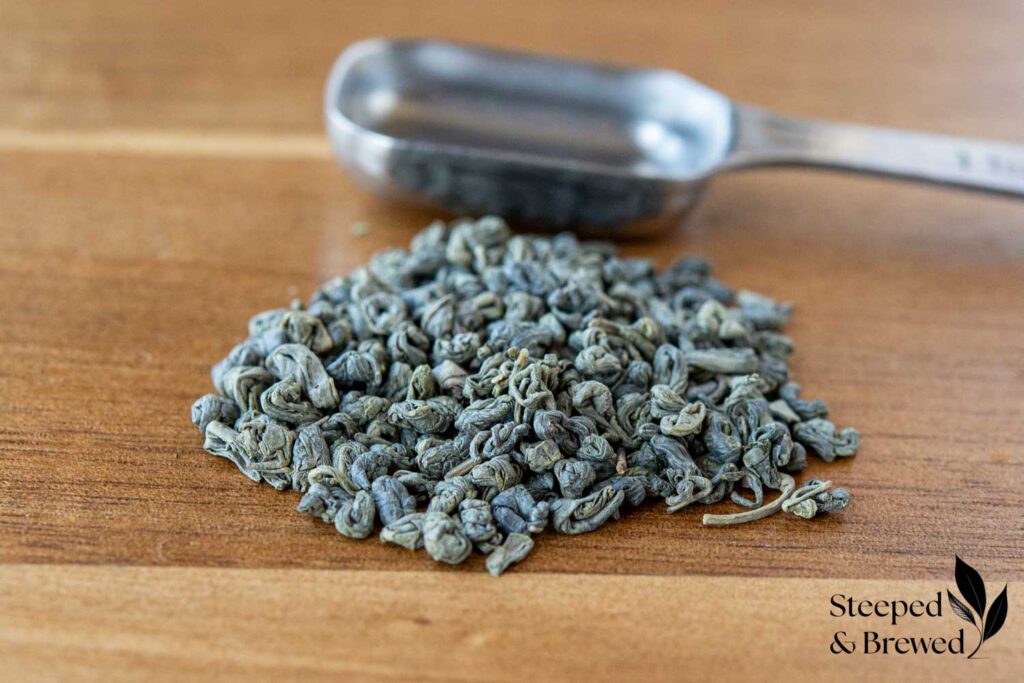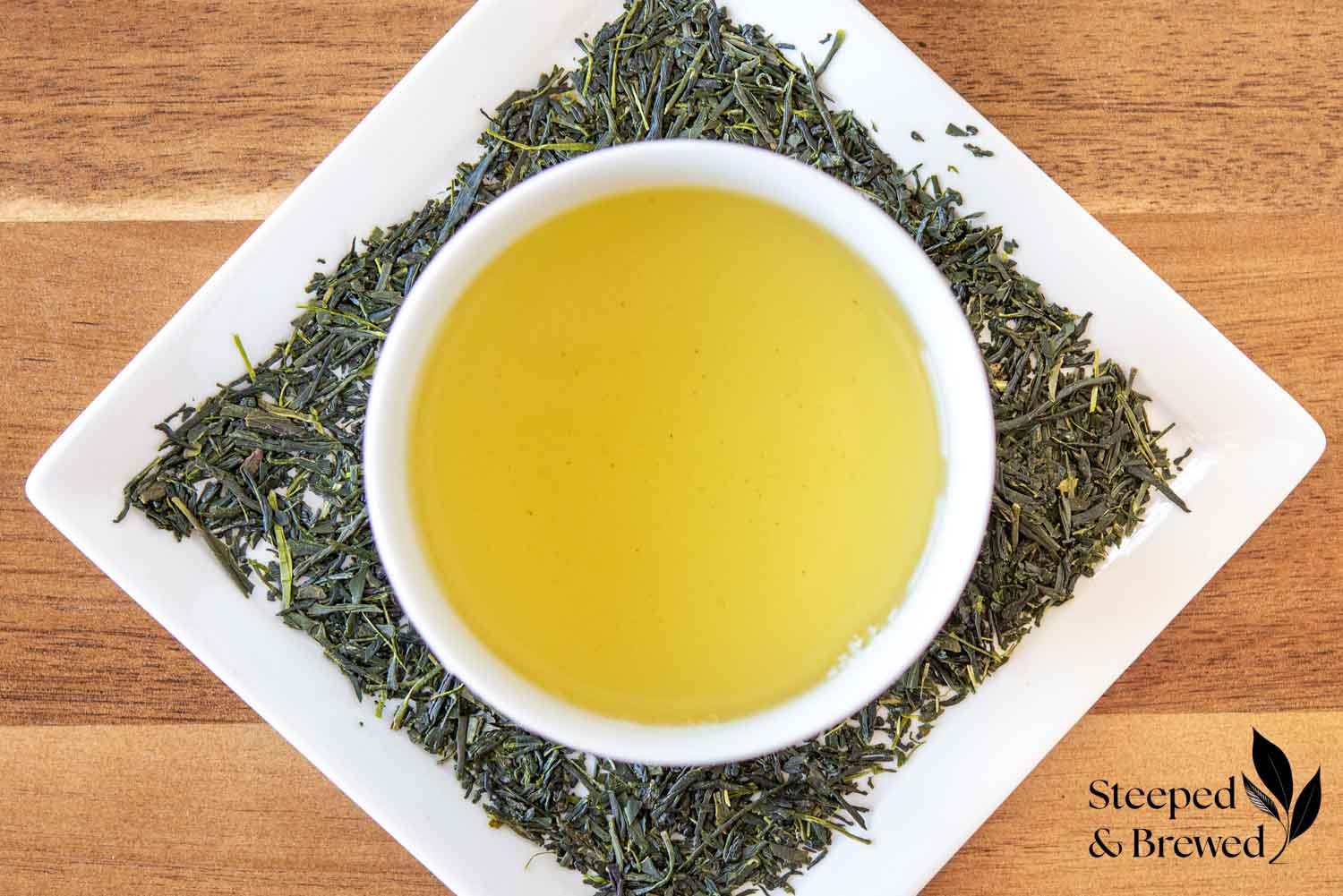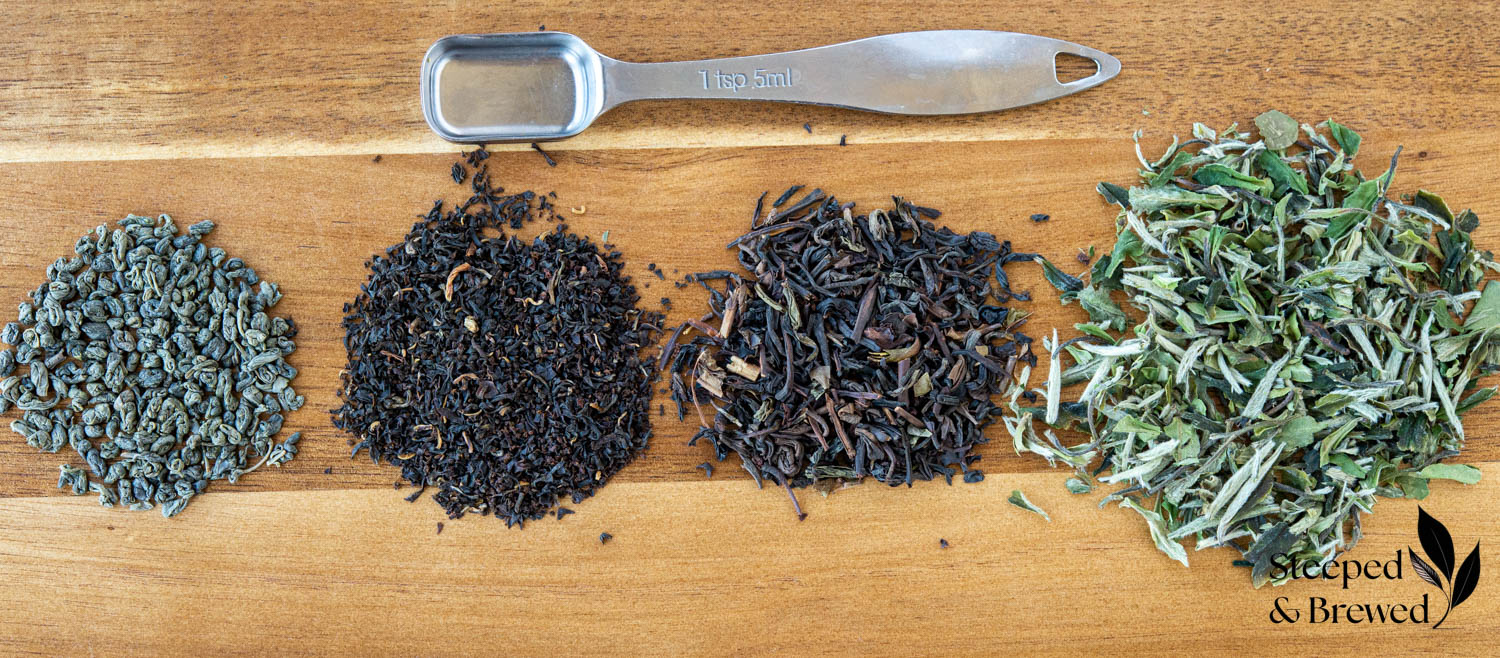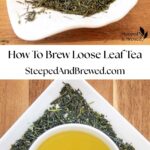This post may contain affiliate links. That means if you click on a link and make a purchase, I may make a small commission at no additional cost to you. Thank you for your support!

Hello friends! What do you say we get to brewing some tea? In this guide, we’ll explore the ins and outs of Western-style tea brewing – a style that’s both approachable for beginners and offers plenty of breadth for the most discerning tea enthusiasts.
But before we begin, I encourage you to remember that tea brewing is as personal as it is versatile. It’s an art, a science, and an expression of personal taste. Be encouraged to experiment, adjust, and discover what works best for you. Whether you’re steeping a robust black tea or a delicate green tea, the journey is all about finding your perfect cup. So grab your favorite teapot, and let’s get brewing!
Note from Julie
I have researched countless sources, looking for a perfect, one-size-fits-all tea brewing formula. Long story short – there isn’t one. The information available varies tremendously. Standards of measures aren’t consistent. Different types of teas require different things. And everybody’s taste is different.
So this brewing guide is based on my taste preferences and experiences. I like a strong, full-bodied brew. If you’re like me, then this guide is for you!
How to brew a cup of loose leaf tea, the short-ish answer
For most loose leaf teas, to brew a full-bodied cup, steep 4 grams (about 1 to 1 1/2 teaspoons) of tea leaves in 8 ounces of water just off the boil. Steep for 3 to 4 minutes, adjusting the volume of tea and steeping time to your taste.
If you would like a few more details and specifics, read on!
Loose leaf tea steeping details
Quantity of tea per cup
As a rule of thumb, use about 4 grams of tea for every 8 ounces of water, adjusting to your taste.
I find it easiest to weigh tea leaves (see the equipment section below), but if you don’t have a kitchen scale, use 1 to 1 1/2 teaspoons of tea for every 8 ounces of water. Keep in mind that tea leaves come in a wide range of shapes, with more compact leaves requiring less volume, and lighter, full-leaf teas requiring more.
Also, remember that many mugs hold much more than 8 ounces of water, so adjust your measurements accordingly.
Temperatures and time
The general rule is lighter teas need milder temperatures of 175°F (79°C) to 195°F (90°C), steeped for 2 to 3 minutes. Robust, darker teas prefer hotter temperatures of nearly 212°F (100°C), steeped for 3 to 5 minutes.
Tea steeping process
Suggestions for brewing different types of teas
If you would like to learn more about the 6 main types of teas, hop over to my article, What’s in your cup: An Easy Guide to the 6 Main Types of Tea.

Tea brewing tools and equipment
This article focuses on Western-style brewing for loose leaf tea. Though not many tools are needed, a few can definitely enhance your tea brewing and enjoying experience.
Tea kettle
Nothing too complicated here! You simply need something to boil water in. An electric tea kettle is handy, but a stovetop kettle or even a pot will work. Ideally, look for something easy to pour from kettle to cup without weighing too much or spilling water everywhere.
If you are feeling fancy, there are electric kettles that will heat water to precise temperatures – handy for brewing more delicate teas that should be steeped at lower temperatures.
Thermometer
Different teas need different temperatures to extract their best flavors. If the water is too hot, your tea might taste bitter. If it’s not hot enough, the tea could taste weak or ‘flat.’ So if you want to be precise with your brewing, a thermometer is a handy tool.
If precision isn’t your thing, simply allow boiled water to cool for about 5 minutes before steeping lighter teas such as green or white tea.
Kitchen scale
Now we are getting really nerdy! A kitchen scale can be your secret weapon for consistent tea brewing. This nifty tool allows you to precisely measure the amount of tea leaves you’re using, ensuring your cup of tea has the level of intensity you prefer.
While a general rule of thumb is to use about 1 to 1 1/2 teaspoons of loose tea for every 6 to 8 ounces of water, using a kitchen scale for measurement can dramatically improve the accuracy. For example, some teas such as white or oolong can be quite light and fluffy, so a teaspoon might not be enough for the desired flavor. On the other hand, tightly rolled teas like gunpowder green tea can be quite heavy, requiring less volume per cup.
The general rule for weighing tea is to use about 4 grams of tea leaves for every 6 to 8 ounces of water, adjusting to your taste. More leaves make for a stronger cup, and less for a weaker cup.

Tea infuser or strainer
A proper tea infuser should be large enough to allow tea leaves to move around freely. This freedom of movement provides room for the tea leaves to unfurl completely during the steeping process. As they unfurl, they release their full flavor into the water.
So avoid those teeny-tiny tea balls. While they might be economical, they don’t typically offer enough space for the tea leaves to expand, especially larger, whole-leaf varieties. This could lead to a less flavorful brew that doesn’t do justice to your choice of tea. So, when choosing an infuser, choose one that provides ample room for your tea leaves to unfurl and truly reveal their potential.
Another option is a tea strainer. This is a good choice if you prefer to use a teapot for steeping your tea leaves. Simply put the leaves directly into the pot and steep them to your liking. Once the steeping process is done, pour your delicious brew through the strainer and directly into your cup. Don’t confuse a strainer for an infuser, though. Infusers are deep with lots of room for the leaves to move around. Strainers are shallow and intended to catch leaves as the steeped tea is poured from a pot.
Supplies from Amazon
 Buy Now →
Buy Now →  Buy Now →
Buy Now →  Buy Now →
Buy Now → Frequently Asked Questions
How does the brewing time affect the taste of the tea?
Brewing time greatly impacts the taste profile of your tea. Simply put, the longer you steep the tea, the stronger it becomes. This has to do with the fact that teas are full of naturally occurring chemicals such as tannins, caffeine, and flavonoids. As you steep your tea leaves, these chemicals start to infuse into the water.
Steeping tea for too short of a time can lead to a weak brew while steeping too long can lead to an overly bitter cup. It’s a delicate balancing act between drawing out the flavors you enjoy and preventing the over-extraction of bitter elements. Stick to the recommended brewing times for each type of tea and adjust as necessary to match your personal preference. Keep in mind, if you want to brew a stronger cup, it is generally better to add more tea leaves rather than steeping for a longer period.
Tea brewing is an art, and you’re the artist, so feel free to experiment!
How does the quality of water affect tea brewing?
The quality of water you use can greatly impact the way your tea tastes. The mineral content in your water, or its “hardness,” can affect your tea’s flavor. Hard water can add off flavors. But water that’s too soft, with few minerals, can make your tea taste boring and flat.
Ideally, use freshly drawn, clean, neutral water. This type of water lets the tea’s flavors stand out. If your local water supply doesn’t fit the bill, filtered or spring water are both good options; they contain minerals but don’t overpower the taste of the tea. Try to avoid distilled water as it lacks minerals, potentially making some teas taste less flavorful.
Is there a difference between brewing loose leaf tea and tea bags?
Loose leaf tea is often preferred over tea bags because it is typically better quality with a stronger flavor. The larger, less torn leaves in loose tea can produce rich, full-bodied flavors and scents when brewed. On the other hand, tea bags tend to have smaller, broken leaves and even tea dust that can make the tea taste bitter, less rich, weaker, and sometimes murky. So, if you’re looking for a more enjoyable and sophisticated tea-drinking experience, loose leaf tea is generally the way to go.
Having said that, there’s a rising trend among manufacturers to produce tea sachets filled with the same high-quality tea leaves as those you’d find in loose form. This gives tea lovers the convenience they seek without compromising on quality. Speaking from personal experience, I’m the kind of tea drinker who prefers a stronger brew and I often end up using a larger-than-average quantity of tea per cup. So my go-to is typically loose leaf tea. If, like me, you’re also seeking more control over the strength of your tea, you may find loose tea to be your preferred choice.
How can I adjust brewing methods for stronger or weaker tea?
If you want a stronger tea, use more tea leaves, but avoid steeping for too long to prevent bitterness. Steeping longer typically increases bitterness, not flavor.
For a weaker tea, use fewer leaves or reduce steeping time. This provides a milder brew as the tea has less time to infuse the water.
Temperature also affects tea strength. For example, lower temperatures result in sweeter, floral flavors, while higher temperatures create more robust infusions.
Don’t be afraid to adjust the amount of tea, steeping time, and temperature to find your ideal brew. After all, enjoying your tea is what matters most.
Why does my brewed tea taste bitter?
Tasting a bit of bitterness in your brewed tea is normal, particularly in black and green types. But, if the bitterness is too strong, it might be due to over-steeping. The longer you steep, the more tannins are released into the water, causing bitterness. Try cutting down the steeping time just by a minute or two and you’ll see the difference.
The right temperature is important, too. High temps could extract more tannins, resulting in a bitter taste. Each tea type has its ideal temperature – try to stick close to the recommendations for the best flavor.
The quality of the tea leaves also matters. Poor-quality leaves can result in a bitter brew.
Don’t get disheartened if your first few brews taste bitter. With some tweaking around steeping time, temperature, and quality of leaves, you’ll get to the perfect cup of tea soon.
Can tea be re-steeped?
Any tea can be re-steeped, but some types of tea are better suited for re-steeping than others. For instance, pu-erh and oolong teas are known for their unique ability to develop new and complex flavors with each infusion. High-quality loose leaf teas in general are much better suited for re-steeping than low-quality teabags. So the next time you’re enjoying a cup of tea, consider giving it another steep to unlock even more delicious flavors!
Should I add milk, sugar, or lemon to my tea?
It all depends on your taste! The decision to add milk, sugar, or lemon to your tea is a matter of personal preference, but it is most common with black tea. In some cultures, it’s customary to add milk and sugar to certain black teas, such as English Breakfast or Assam.
Lemon is often paired with teas that have a more citrusy flavor like Earl Grey or Ceylon blacks that have a natural citrus note. Green tea and lemon is another popular pairing.
For tea purists, drinking tea without any additions allows you to appreciate its authentic flavors. The choice is yours! Experiment and discover what you enjoy most.


